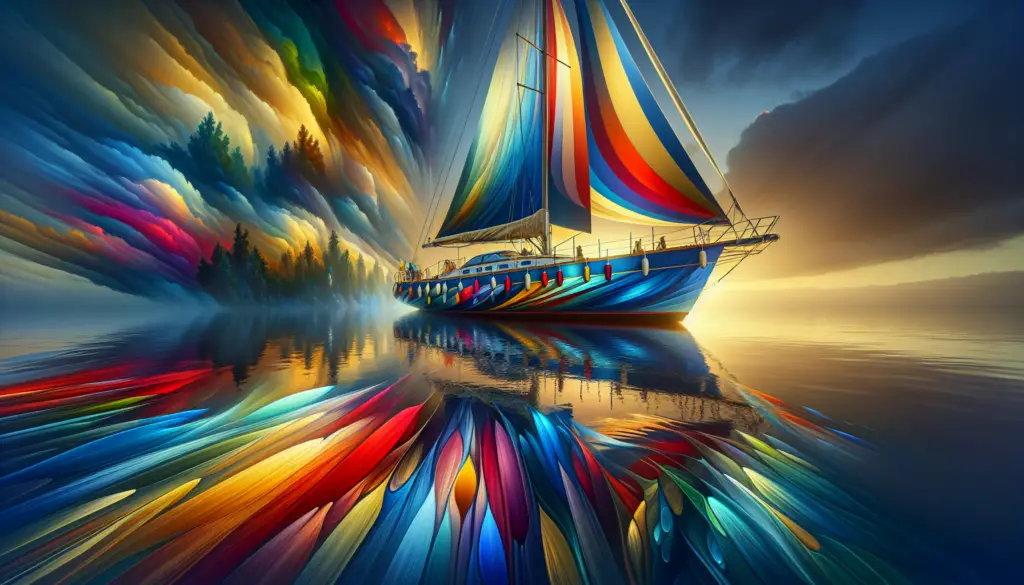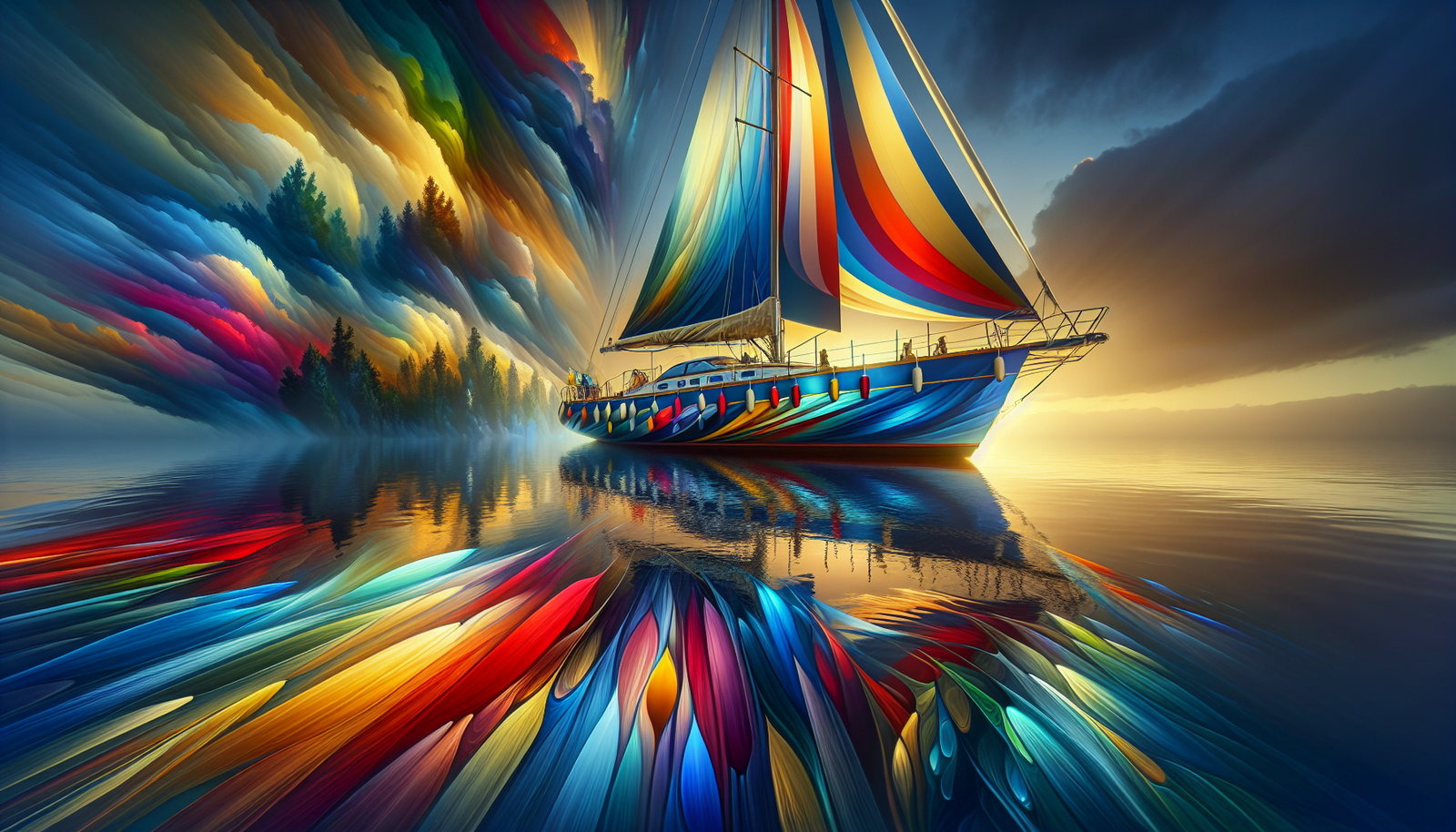If you’re looking to add a personal touch to your boat, exploring different paint options is the way to go. Whether you want to stand out on the open waters or showcase your unique style, choosing the right paint can make all the difference. From vibrant and eye-catching colors to sleek and sophisticated finishes, this article explores the most popular paint options for boat customization. Let’s dive in and discover the paint options that will transform your boat into a true reflection of your personality and taste.

1. Gelcoat
Gelcoat is a popular choice for boat customization due to its many benefits. Firstly, gelcoat provides a protective layer that helps to prevent damage from harmful UV rays, chemicals, and water. It acts as a barrier, keeping your boat’s surface looking fresh and new for a longer period of time. Secondly, gelcoat offers excellent resistance to scratches and abrasions, ensuring that your boat maintains its sleek appearance even after years of use. Lastly, gelcoat is available in a wide variety of colors, allowing you to choose the perfect shade to match your personal style and preferences.
When it comes to applying gelcoat, the process is relatively straightforward. First, the surface of the boat must be thoroughly cleaned and sanded to create a smooth and even base. Next, the gelcoat is mixed with a catalyst to initiate the curing process. It is then applied evenly using a brush, roller, or spray gun, depending on the desired finish. Once the gelcoat has cured, it can be polished and buffed to achieve a glossy shine.
There are different types of gelcoat available, each with its own unique properties. The most common types include standard gelcoat, which is suitable for most applications, and high-performance gelcoat, which offers enhanced durability and resistance to harsh environmental conditions. Additionally, there are gelcoats specifically formulated for different types of materials, such as fiberglass or aluminum, ensuring optimal adhesion and compatibility.
Choosing the right gelcoat color is an important decision for boat customization. The color you select can greatly impact the overall aesthetic of your vessel. Popular gelcoat colors include classic neutrals such as white, cream, and gray, which offer a timeless and elegant look. For a bolder statement, vibrant hues like blue, red, and yellow can add a pop of color and personality. Ultimately, the choice of color depends on your personal taste and the look you want to achieve for your boat.
2. Polyurethane
Polyurethane is another popular option for boat customization, thanks to its numerous advantages. Firstly, polyurethane provides excellent resistance to UV rays, preventing color fading and maintaining the vibrant appearance of your boat. It is also highly durable and resistant to scratches, ensuring that your boat looks pristine even in harsh conditions. Furthermore, polyurethane is known for its long-lasting finish, reducing the need for frequent touch-ups or repaints.
To apply polyurethane to your boat, start by preparing the surface through cleaning and sanding. Next, apply a coat of primer to promote adhesion and create a smooth base for the polyurethane. Once the primer has dried, the polyurethane can be applied using a brush, roller, or spray gun. Multiple coats may be required, with sanding between each coat for optimal results. Finally, a topcoat or clear coat can be added to enhance the gloss and protection of the polyurethane finish.
When it comes to choosing polyurethane colors, there is a wide range of options available. Classic colors like white, black, and navy blue are popular choices for a timeless and sophisticated look. However, polyurethane also offers the opportunity to explore more unique and bold colors, such as metallic shades or vibrant hues. The color selection depends on your personal style and the desired aesthetic for your boat.

3. Epoxy
Epoxy is a versatile paint option for boat customization, offering various benefits. Firstly, epoxy provides exceptional adhesion to a wide range of surfaces, making it suitable for different boat materials such as fiberglass, wood, and metal. It forms a strong bond with the surface, ensuring long-lasting results. Additionally, epoxy is highly resistant to water, chemicals, and UV rays, protecting your boat from environmental damage. It is also known for its excellent durability and abrasion resistance, making it a reliable choice for boat customization.
To apply epoxy to your boat, start by cleaning and preparing the surface. It is important to ensure that the surface is dry and free from any contaminants to promote proper adhesion. Next, mix the epoxy components according to the manufacturer’s instructions. Apply the epoxy using a brush or roller, working in small sections to ensure even coverage. Finally, allow the epoxy to cure according to the recommended drying time.
Epoxy paints come in a range of colors, allowing you to customize your boat to your desired look. Classic colors like white, blue, and green are popular choices for a clean and nautical appearance. However, epoxy also offers the opportunity to explore more vibrant colors or create unique patterns and designs. The color options are virtually limitless, providing endless possibilities for customization.
4. Acrylic Enamel
Acrylic enamel is a versatile and popular choice for boat customization, offering several advantages. Firstly, acrylic enamel provides excellent color retention and UV resistance, ensuring that your boat’s vibrant appearance is maintained even under prolonged sun exposure. It is also highly durable and resistant to fading, chipping, and cracking, ensuring that your boat looks great for years to come. Additionally, acrylic enamel provides a glossy finish that enhances the overall aesthetic of your boat.
To apply acrylic enamel to your boat, start by preparing the surface through cleaning and sanding. Next, apply a primer to promote adhesion and create a smooth base for the acrylic enamel. Once the primer is dry, the enamel can be applied using a brush, roller, or spray gun. Multiple coats may be needed for optimal coverage and durability. Finally, a clear coat can be added to further enhance the shine and protection of the acrylic enamel finish.
When it comes to choosing acrylic enamel colors for your boat, there is a wide range of popular options. Classic colors like white, black, and navy blue are timeless choices that offer a clean and sophisticated look. Additionally, acrylic enamel allows for experimentation with bold and vibrant colors, such as red, yellow, or even metallic shades. The color selection depends on your personal style and the desired aesthetic for your boat.

5. Vinyl Wraps
Vinyl wraps have become increasingly popular for boat customization due to their numerous benefits. Firstly, vinyl wraps offer a cost-effective alternative to repainting your boat. They are relatively easy to install and can be done by professionals or even as a DIY project. Vinyl wraps also provide excellent protection against UV rays, scratches, and other environmental damage, ensuring that your boat looks great for years to come. Additionally, vinyl wraps offer a wide variety of designs, patterns, and colors, allowing you to achieve a unique and personalized look for your boat.
The application process for vinyl wraps involves thoroughly cleaning and preparing the boat’s surface. Next, the vinyl wrap is carefully applied and smoothed out using specialized tools, such as heat guns and squeegees. The wrap is then carefully trimmed and fitted to achieve a seamless and professional finish. With proper installation and maintenance, vinyl wraps can last for several years, providing a durable and vibrant look for your boat.
Popular vinyl wrap designs for boats vary greatly depending on personal taste and style. Nautical themes, such as waves or marine life, are often chosen to complement the boat’s environment. Alternatively, vibrant colors or custom graphics can be used to make a bold and unique statement. Some boat owners also opt for vinyl wraps that mimic the appearance of other materials, such as wood or carbon fiber, for a sophisticated and luxurious aesthetic. The design choice is ultimately up to you and the overall look you want to achieve for your boat.
6. Metallic Paint
Metallic paint is a popular choice for boat customization due to its unique advantages. Firstly, metallic paints offer a reflective and eye-catching finish that adds depth and dimension to your boat’s appearance. The shimmering effect that metallic paint provides can create a stunning visual impact on the water. Secondly, metallic paints are known for their durability and resistance to fading, ensuring that your boat maintains its lustrous shine for a long time. Lastly, metallic paint allows for creativity and customization, as it can be combined with other colors or used for unique designs and accents.
Applying metallic paint to your boat requires proper surface preparation and priming. It is essential to ensure that the surface is clean and free from any contaminants to ensure optimal adhesion. Next, the metallic paint is applied using a brush, roller, or spray gun. Multiple coats may be needed to achieve the desired level of metallic effect and coverage. Finally, a clear coat can be added to enhance the gloss and protection of the metallic paint finish.
Metallic paint colors for boats offer a wide range of options, allowing for customization and personalization. Classic and timeless colors such as silver, gold, and bronze are popular choices that offer a sophisticated and elegant look. However, metallic paints also come in various vibrant and eye-catching hues like blue, red, or green, which can add a bold and modern statement. Additionally, metallic paints can be combined with other colors or used for unique designs and accents to achieve a truly customized look for your boat.

7. Bottom Paint
Bottom paint serves a specific purpose in boat customization, primarily to protect the hull and prevent marine growth. The purpose of bottom paint is to create a barrier between the boat’s hull and the water, preventing the attachment of algae, barnacles, and other organisms. Bottom paint contains biocides that deter marine growth, helping to maintain the performance and efficiency of your boat.
There are different types of bottom paint available, each with its own unique properties. Hard bottom paint is durable and long-lasting, making it suitable for boats that are frequently used. On the other hand, ablative bottom paint gradually wears away over time, continuously releasing biocides to prevent marine growth. This type of bottom paint is recommended for boats that are used intermittently or stored out of the water for extended periods.
The application process for bottom paint involves thorough cleaning and preparation of the hull. Any existing paint or marine growth must be removed before applying the bottom paint. Next, the bottom paint is applied using a brush or roller, following the manufacturer’s instructions for the recommended number of coats and drying times. It is important to ensure that the bottom paint is applied evenly and covers the entire hull for maximum protection.
Popular bottom paint colors include classic options such as black, blue, and green. These colors offer a traditional and timeless look for boats, while also effectively concealing any marine growth that may occur over time. However, bottom paint colors can also be customized to match the overall aesthetic of your boat. Some boat owners opt for lighter colors like white or light gray, which can offer a sleek and modern appearance, while still providing effective protection against marine growth.
8. Anti-Fouling Paint
Anti-fouling paint is specifically designed to prevent the attachment of marine organisms, such as algae, barnacles, and mussels, to the boat’s hull. This type of paint contains biocides that deter marine growth, protecting the boat’s performance and efficiency. Anti-fouling paint is particularly important for boats that are frequently in the water or stored for extended periods, as marine growth can significantly affect speed, fuel efficiency, and overall maneuverability.
The benefits of using anti-fouling paint are numerous. Firstly, it helps to maintain the boat’s performance by preventing drag caused by marine growth. By reducing drag, the boat can achieve higher speeds with less fuel consumption. Secondly, anti-fouling paint minimizes the need for frequent hull cleaning and maintenance, saving time and effort. Lastly, anti-fouling paint improves the overall appearance of the boat by preventing unsightly algae and barnacle growth.
The application process for anti-fouling paint is similar to that of bottom paint. The hull must be thoroughly cleaned and prepared, ensuring that any old paint or marine growth is removed. Next, the anti-fouling paint is applied evenly using a brush or roller, following the manufacturer’s instructions for the recommended number of coats and drying times. It is important to ensure that the anti-fouling paint fully covers the hull to provide maximum protection against marine growth.
Popular anti-fouling paint colors include darker shades such as black, blue, and green. These colors offer effective concealment of any marine growth that may occur over time, while also providing a traditional and timeless look for boats. However, anti-fouling paint colors can also be customized to match the overall aesthetic of your boat. Lighter colors like white or light gray can provide a sleek and modern appearance, while still effectively deterring marine growth.

9. Two-Tone Paint
Creating a two-tone design for your boat can add a unique and stylish touch to your customization. Two-tone paint involves using two different colors to divide the boat’s hull into distinct sections, creating visual interest and dimension. This type of paint design allows for creativity and personalization, as it offers numerous possibilities for color combinations and placement.
To create a two-tone design, start by selecting the colors you want to use. Consider the overall look you want to achieve and the colors that complement each other. Classic combinations include white and navy blue, white and black, or white and red. However, you can also opt for more vibrant combinations like blue and yellow, green and orange, or any other colors that reflect your personal style and preferences.
The application process for a two-tone design involves masking off the areas where the colors will be divided. Use masking tape or specialized masking products to create clean lines and prevent color bleeding. Start by applying the lighter color first, allowing it to dry before masking and applying the second color. Make sure to remove the masking tape carefully to avoid damaging the paint.
Popular two-tone paint combinations vary greatly depending on individual taste and style. Classic and timeless combinations like white and navy blue offer a clean and sophisticated look. On the other hand, bold and vibrant combinations like red and yellow or green and orange can create a fun and eye-catching appearance. Ultimately, the choice of colors depends on your personal style and the overall aesthetic you want to achieve for your boat.
10. Custom Designs
Working with a professional can help you bring your vision to life and create a truly unique and customized boat design. Professionals experienced in boat customization can provide valuable input and expertise, ensuring that your boat reflects your personal style and preferences. They can help you select the right materials, colors, and finishes to achieve the desired look for your boat.
The application process for custom boat designs varies depending on the specific design and materials used. It often involves a combination of techniques, such as airbrushing, hand-painting, or vinyl wrapping. Working with a professional ensures that the design is applied accurately and seamlessly, resulting in a professional finish.
Examples of custom boat designs are vast and diverse, showcasing the creativity and personalization that is possible. Nautical themes, such as waves, fish, or anchors, are popular choices for boat designs, reflecting the boat’s environment and purpose. Additionally, custom designs can range from intricate patterns and geometric shapes to realistic scenes and portraits. The options are virtually limitless, allowing you to create a design that is as unique as your boat.
In conclusion, boat customization offers an array of options for creating a personalized and unique vessel. From gelcoat and polyurethane to vinyl wraps and custom designs, there is a paint option to suit every style and preference. Whether you prefer a timeless and classic look or want to make a bold statement, the possibilities are endless. Consider the benefits, application process, and popular colors of each paint option to find the perfect choice for your boat customization project. Collaborating with professionals can also help bring your vision to life and ensure a professional and polished finish. Customize your boat to reflect your personality and enjoy a one-of-a-kind vessel that stands out on the water.

